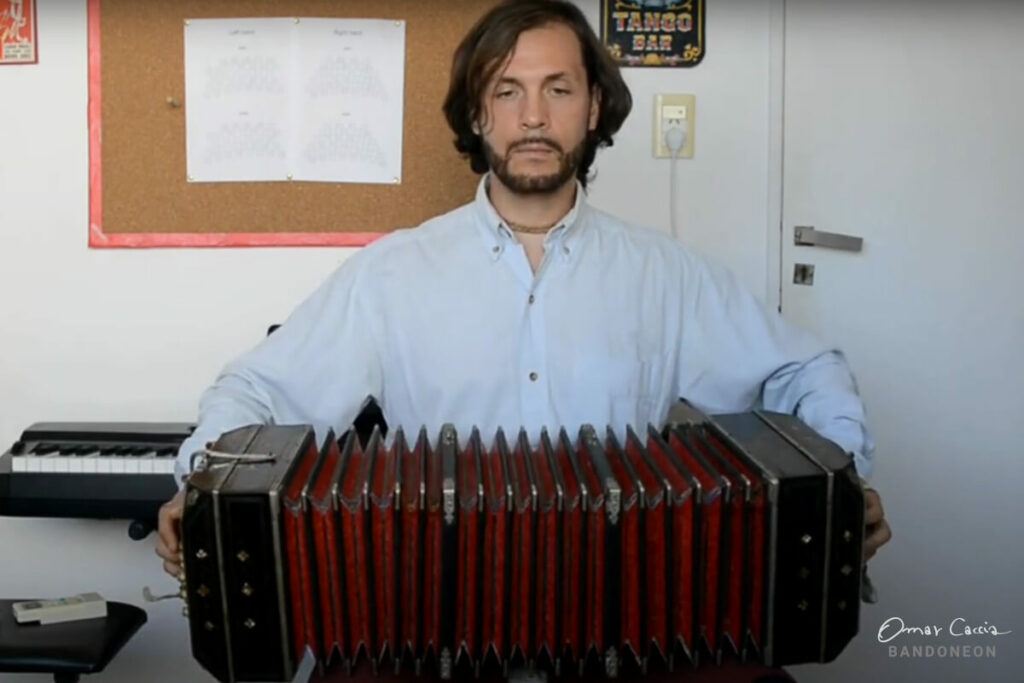
Bandoneón Tutorial: The Inicial 1
In this bandoneón tutorial I explain the first of a series of preparatory exercises. After having dedicated a series of videos to the fundamental aspects
Today, we’re talking about two instruments that are often confused: the accordion and the bandoneon. Both are bellows instruments, so it’s easy to think their playing techniques are similar.
Many accordion players start playing the bandoneon, and I did the same—I played the accordion before switching to the bandoneon. So, I decided to write an article about the 3 most common mistakes to avoid if you’re an accordionist wishing to play the bandoneon or have just started.
This article applies to both the diatonic bandoneon (or bisonoric) and the chromatic bandoneon (or unisonoric). The core technique of playing the bandoneon is in the bellows, not the keyboard, so all bandoneons are the same in this sense.
Before we continue, please show your support by liking the video, subscribing to the YouTube channel, subscribe to the newsletter and sharing the article with your friends. Thank you!
In the accordion, your right forearm is free to move across the keyboard, and your left hand slides vertically inside the strap to reach all the bass buttons.
The bandoneon is different. Your hand is completely locked up by a strap and you need to rotate the hand to reach different points on the keyboard, always maintaining a fixed rotation point where the strap rests on your hand. You should never abandon this fixed point, or you’ll lose your reference on the keyboard.

So, the mistake to avoid is sliding your hand vertically inside the strap to reach different points on the keyboard. Remember: your hand has a fixed point and rotates around it to reach all parts of the keyboard. Check out my video post on the correct hand position if you haven’t seen it yet.
The accordion is strapped to your chest and back, keeping the right keyboard firmly against your body while the bass keyboard is free to move.
The bandoneon, on the other hand, is not strapped to your body and can move in all directions. Its only support comes from your legs, which is a variable support depending on your leg height and distance.
So, the mistake to avoid is keeping the right keyboard still and only moving the left keyboard, as if it were the bass keyboard of the accordion.
This is wrong whether you rest the bandoneon on both legs but move only one, or rest it on one leg only.
Both keyboards of the bandoneon open and close together with the movement of your legs, extending in both directions. Check out my video post on the fundamental details of posture if you haven’t seen it yet.
In the accordion, the airflow is produced by moving the bass keyboard, while the right keyboard is fixed. The correct opening and closing of the accordion bellows is a fan-like movement, so you don’t fatigue your shoulder and forearm by holding the heavy bass keyboard.
The bandoneon is different: it’s supported by both legs, so you can’t use its weight to produce sound. If you try, the keyboards will quickly reach the ground, an uncomfortable position for your wrist. Plus, to close the bellows, you would have to lift the keyboards upward in a big, uncomfortable movement that can disturb your playing.
Instead, you need to pull the two keyboards while keeping a straight line, called the linea de tiro or pulling line. The closing movement also follows this line, with each force converging to the center. This line helps unify your hand and wrist position when opening and closing, minimizing direction changes in the bellows and making your playing smoother.

Unlike the accordion, with the bandoneon, you’re slightly supporting the weight of the two keyboards. This minimal support gives you better control of the instrument during both opening and closing, resulting in a better sound. If you wish to go deeper into this concept, I recommend you to watch my video posts on the “linea de tiro” and hand support if you haven’t seen them yet.
In my experience, these 3 mistakes are the biggest ones that can slow down or block your progress with the bandoneon if you come from the accordion background. Once you correct these three mistakes and get used to the different technique, learning the bandoneon becomes much easier and more natural.
If you liked this article and found it helpful, please share it with your friends. Also, I’m available for online bandoneon lessons; you’ll find the link with details here.
That’s all for this article. If you have any suggestions, feel free to leave a comment.
Take care, have fun and… a estudiar y a tocar!

In this bandoneón tutorial I explain the first of a series of preparatory exercises. After having dedicated a series of videos to the fundamental aspects

Learn about chromatic bandoneons! Download FREE PDF keyboard layouts for Peguri, Manoury, & Crosio-Caliero systems. Unisonoric bandoneon explained for beginners.

A Lesson from the Bandoneon to Move from Stage Panic to Expressiveness 2024 is coming to an end and I have been very busy during

Who is Fred Dömpke and why should deserve more consideration among the bandoneon players? The bandoneon is conquering a significant role in jazz. Many bandoneon

The Bandoneon Price depends on the type of Bandoneon you want to buy. The equation is simple: if you want to learn to play the

Discussing Bandoneon Making with Baltazar Estol A few years ago I saw a video by M. Rodolfo Daluisio playing a bandoneon built by Baltazar Estol.